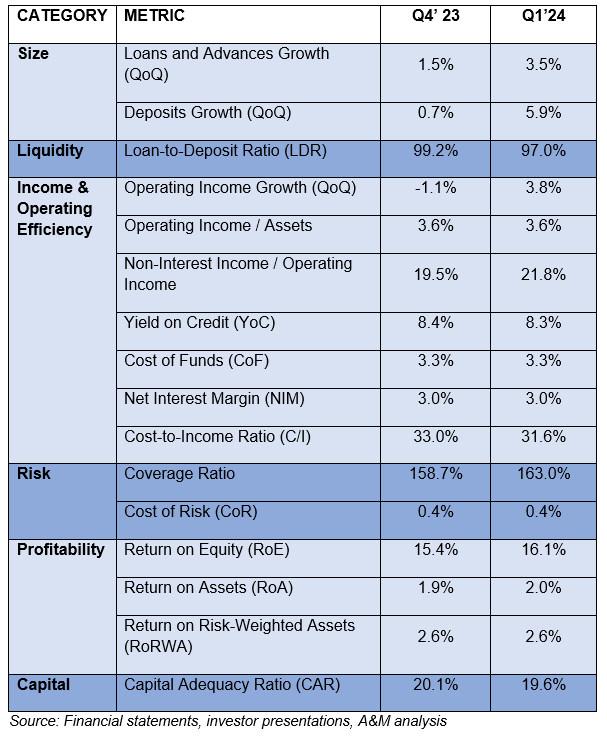- Significant growth in operating income (+3.8 percent) mainly on the back of higher fee income.
- Deposits grew at a faster rate than loans.
- Earnings prospects will likely remain subdued due to rate reversal in H2 2024, squeezing profitability and margins.
Kingdom of Saudi Arabia – 5 June 2024 – Leading global professional services firm Alvarez & Marsal (A&M) today released its latest KSA Banking Pulse for Q1 2024. The report shows that deposits of the main Saudi banks grew at a faster pace (+5.9 percent) than loans & advances (L&A) (+3.5 percent) quarter on quarter (QoQ). Consequently, the loans-to-deposit ratio (LDR) retreated by 2.2 percent QoQ on higher deposit growth, to be at 97 percent in Q1'24.
Operating income increased by 3.8 percent QoQ, majorly due to growth in non-core income (+16.2 percent QoQ) with marginal growth in net interest income (NII) (+0.8 percent QoQ). Furthermore, impairment charges (+10.7 percent QoQ) subdued the growth in net income (+6.0 percent QoQ).
Banks reported improved cost efficiency as cost-to-income (C/I) ratio decreased by 1.4 percent QoQ; Overall, return on equity (RoE) increased 0.7 percent QoQ to 16.1 percent while return on assets (ROA) increased marginally by 0.1 percent to 2.0 percent in Q1'24.
Key prevailing trends identified for Q1 2024 are as follows:
1. Combined L&A of the top ten banks increased by 3.5 percent QoQ, faster than the previous quarter (+1.5 percent QoQ). Total deposits increased by 5.9 percent QoQ; growth in CASA deposits was highest (+8.2 percent QoQ), which drove the aggregate.
2. Operating income increased because of a significant growth in non-interest income despite a slow growth in NII. Total operating income increased by 3.8 percent QoQ to 34.1bn in Q1'24. This was majorly due to 16.2 percent QoQ growth in non-interest income to SAR 7.4bn, whereas NII grew only marginally by 0.8 percent QoQ to SAR 26.7bn.
3. Net Interest Margin (NIM) contracted marginally by 6 bps QoQ to 2.96 percent. Seven of the top ten banks in KSA reported a contraction in NIM. Yield on credit decreased by 7 bps QoQ whereas cost of funds remained stable at 3.3 percent in Q1'24. Overall, at the peak of the interest rates, NII grew marginally (+0.8 percent QoQ) indicating the banks could not reprice all assets favorably. The net spread between yield on credit and cost of funds shrunk marginally by 6bps QoQ in Q1'24. This coupled with decrease in LDR by 2.2 percent QoQ led to NIM contraction.
4. Cost-to-income ratio (C/I) ratio improved for the first time after four consecutive quarters by 138 bps QoQ to 31.6 percent in Q1'24. This was due to fall in operating expense (-0.5 percent QoQ) and rise in operating income (+3.8 percent QoQ) in Q1'24. Majority of the KSA banks reported an improved cost efficiency in Q1'24.
5. Cost of risk (CoR) deteriorated marginally due to higher impairment charges for the quarter. The CoR weakened by 3 bps QoQ to settle at 0.4 percent in Q1'24. Half of the top ten banks reported a deterioration in CoR.
6. Eight out of top ten banks witnessed improved profitability. Higher operating income and improved cost efficiency resulted in ROE expansion. Aggregate net income of KSA banks increased by 6.0 percent QoQ to SAR 18.7bn in Q1'24 despite slow growth in NII (+0.8 percent QoQ). Banks were profitable mainly due to a substantial growth in non-core income (+16.2 percent QoQ) and decreased operational expenses (-0.5 percent QoQ). The increase in net income resulted in RoE expanding to 16.1 percent (+0.7 percent QoQ) and RoA expanding to 2.0 percent (+0.1 percent QoQ) for the quarter.
A&M's KSA Banking Pulse examines data of the 10 largest listed banks in the Kingdom, comparing the Q1 2024 results against Q4 2023 results. Using independently sourced published market data and 16 different metrics, the report assesses banks' key performance areas, including size, liquidity, income, operating efficiency, risk, profitability, and capital.
The country's 10 largest listed banks analyzed in A&M's KSA Banking Pulse are Saudi National Bank (SNB), Al Rajhi Bank, Riyad Bank (RIBL), Saudi British Bank (SABB), Banque Saudi Fransi (BSF), Arab National Bank (ANB), Alinma Bank, Bank Albilad (BALB), Saudi Investment Bank (SIB) and Bank Aljazira (BJAZ).
OVERVIEW
The table below sets out the key metrics:

Mr. Asad Ahmed, Managing Director and Head of Middle East financial services at A&M commented: "
The positive tone on Q1 2024 performance follows a strong 2023 for bank profits. Profitability ratios for the current fiscal improved as bank's fees and non-interest income contributed to the growth.
While SAMA continues to follow US fed with respect to the benchmark interest rates, we expect higher interest rates will constrain mortgage lending growth in FY'24. A downward rate adjustment is being predicted in the second half though both the timing and the size of the cuts have gone though many predictive revisions; nevertheless, lower rates are likely to gradually affect margins; banks will need to increase their focus on fee and transactional banking income.
We also can expect a continued focus on costs throughout 2024."
Originally published 5 June 2024
The content of this article is intended to provide a general guide to the subject matter. Specialist advice should be sought about your specific circumstances.


